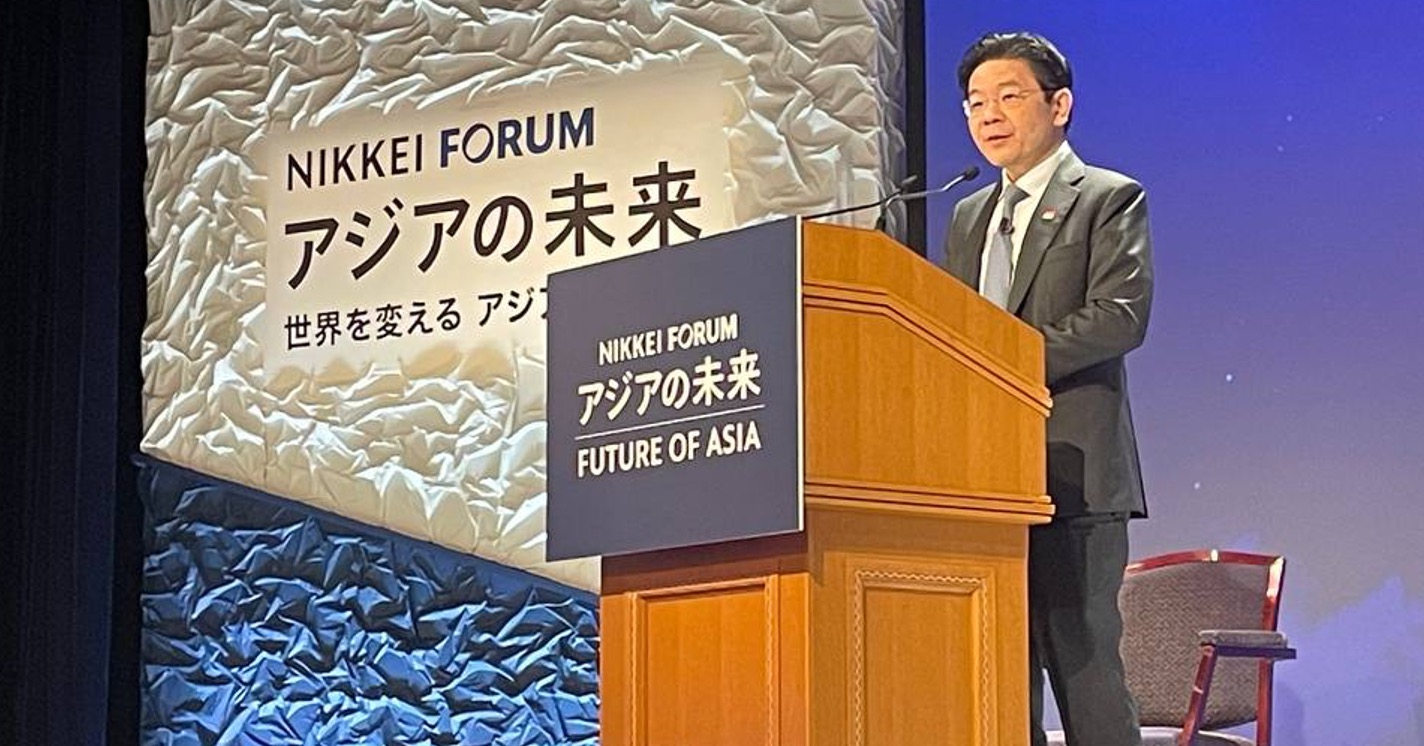Follow us on Telegram for the latest updates: https://t.me/mothershipsg
No one wants a new Cold War in Asia, but while tensions between the U.S. and China are on the rise, other Asian countries and Asean in particular have agency to help shape developments in the region, Deputy Prime Minister and Finance Minister Lawrence Wong said.
While some countries pursued neutrality in the last Cold War, Asean's approach is not one of passive non-engagement, but rather active engagement on a number of levels.
Speaking at the 28th Nikkei Forum on the Future of Asia in Tokyo, Japan on May 25, Wong spoke on great power rivalry, but also on how Asean is working to promote peace and stability in the region.
Peace and stability in the region
Wong named the state of U.S.-China relations as the "first big challenge" and its implications for peace and stability in Asia. He shared that this was on the minds of people he engaged with, both when he visited China and when U.S. visitors came to Singapore.
"Between the U.S. and China there is deep mutual suspicion and fundamental mistrust," Wong said, adding that both sides see it as a zero-sum struggle, with both powers believing each other to be a "strategic danger."
China believes the U.S. is out to contain its rise and deny it from taking its "rightful place in the world", while the U.S. sees China as a strategic competitor and a "grave threat to their interests and values."
The key question, Wong said, is whether competition can refrain from escalating into outright confrontation, and whether the two countries can co-exist and manage their differences.
He added that the region has enjoyed relative peace and stability for 50 years since the end of the Vietnam War, and "we know from painful experience" what happens when the region becomes an arena for rivalries between the great powers.
"The contest during the Cold War led to proxy wars and violence that killed millions. No one wants to see a repeat of this," Wong said.
New rivalry
Unfortunately Asia is experiencing great power rivalry once more, and the risks are most evident in the Taiwan Strait, which Wong called the "most dangerous flashpoint" in the region.
While the relevant parties (China, Taiwan, U.S.) say that policies have not changed, in reality they are reacting to each other, Wong noted.
Wong said that the situation is not static - any single, "incremental" move has its own domestic political pressure, drawing a counter-response from the other.
The risk of an accident or miscalculation leading to direct conflict has considerably increased, even though all sides do not want a direct conflict, he said.
How the situation unfolds depends on the two powers, and while some strategic and ideological differences may be irreconcilable, hopefully they will be able to manage their differences, focus on the issues where they have common ground, and over time, find a basis to work together, Wong added.
Rest of Asia are not bystanders
However, the other Asian countries are not mere bystanders, and they have agency to shape developments in the region.
In particular, the Asean nations do not want to be forced to choose sides, and wish to grow their links with both China and the U.S. Nobody wants to see a new Cold War, and any attempt to either contain China's rise or limit American presence in the region will have "few takers."
Asean has demonstrated its agency by strengthening cooperation among defence and security organisations, both within the region and with external partners.
Asean-centred initiatives like the East Asia Summit, the Asean Defence Ministers Meeting Plus and the Asean Regional Forum provide important platforms for Asean leaders and leaders and senior officials of major powers like the U.S., China, India and Japan to meet and discuss regional issues regularly.
Such efforts help to promote mutual trust and understanding and therefore foster stability.
The Asean way
Other than Asean-led initiatives, Singapore pursues other institutionalised agreements like the Five Power Defence Arrangement and welcomes other security arrangements like AUKUS and the Quad, as long as they support Asean centrality and uphold a secure region and a rules-based order underpinned by international law.
"Collectively, these overlapping platforms form an open and inclusive regional architecture, in which countries big and small can participate," Wong said.
Asean will continue to build on this through the Asean Outlook on the Indo-Pacific. This initiative explicitly rejects zero-sum regional competition and regional dominance by any single power. It also provides a framework for collaboration with all of Asean's partners in areas of mutual interest.
"This is the Asean way to uphold peace and stability in our region. We engage with all the major powers, and we avoid exclusive commitments with any single party," Wong said.
During the Cold War, many developing countries maintained neutrality as part of a non-aligned movement. However, Asean's approach is not about passive non-engagement, but rather, active multi-engagement.
Asean works to bring all the key players together, strive to find common ground and advance cooperation to promote regional peace and stability.
Lawrence Wong in Japan
Wong is in Japan once more, having earlier visited Niigata for the G7 Finance Ministers and Central Bank Governors meetings.
He attended a reception in Tokyo with Singapore citizens who currently reside in Japan, and will be meeting with Japan Prime Minister Fumio Kishida and other political and business leaders.
Related story:
Top image by Andrew Koay.
If you like what you read, follow us on Facebook, Instagram, Twitter and Telegram to get the latest updates.

